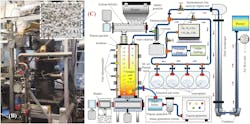Many countries with already overburdened waste-handling strategies were under extreme strain.
The World Health Organization (WHO), Geneva, estimates worldwide monthly use of personal protective equipment (PPE) peaked during the COVID-19 pandemic at 129 billion masks, 65 billion gloves and 1.6 million pairs of goggles.
Many countries with already overburdened waste-handling strategies were under extreme strain. Others collapsed.
According to "The Impacts of Plastic Waste from Personal Protective Equipment Used during the COVID-19 Pandemic" published in Polymers (Basel) journal, Thailand alone saw a three-fold increase, while China, Singapore and the United States experienced significant increases, too.
China’s Hubei province, home to the city of Wuhan where the pandemic is thought to have originated, saw a 370% surge in medical waste predominantly composed of plastic materials.
In India, each COVID-19-infected patient generated approximately 3.41kg/day of biomedical waste. This, combined with the waste generated by regular patients, led to the country running out of incineration capacity on July 13, 2020.
“These statistics emphasize the mounting concern over the increased generation of plastic waste in various regions, underscoring the pressing need for effective waste management strategies and sustainable practices to mitigate the environmental impact caused by such waste,” said the report’s authors.
These figures aren’t the whole story, either. For example, the UK’s National Audit Office (NAO), which oversees government spending, reported in January that the country’s health department has already spent £310 million (US$391 million) to store excess and unusable PPE. Its scathing report also found that the same department reported a write-down of nearly £15 billion (US$19 billion) over the last two years — largely associated with PPE.
Addressing the Waste Issue
However, a team of Lithuanian researchers based at Kaunas University of Technology (KTU) and the Lithuanian Energy Institute has developed a new process for dealing with surgical mask waste (SMW), which makes up a large part of the overall PPE waste.
Focusing primarily on FFP2 face masks — which typically contain individual layers of non-woven material made of polypropylene (PP), polyethylene (PE) and polyamide (PA) — the process uses plasma steam gasification to convert SMW into hydrogen-rich syngas.
A shredding step reduces the masks to a uniform particle size, which are then converted to granules for easier handling during treatment (see Figure 1). The granules are passed into a continuous plasma gasification system with a feed capacity of 10 kg/hr and a DC arc plasma energy of 59.4 kW.
The researchers studied the effect of different gasification parameters, such as arc plasma energy and water vapor on the yield and composition of the syngas produced.
According to a recent report published the International Journal of Hydrogen Energy, the optimal process conditions were plasma arc energy of 56.9 kW, plasma temperature of 2,600 K and a water vapor/SMW ratio of 1.45.
The syngas yield was 3.4 m3/kg of SMW and contained 49.21% hydrogen, 21.7% carbon monoxide, 12.78% methane, 5% carbon dioxide and 2.91% acetylene. The researchers note the syngas heating value of 14.5 MJ/Nm3 is 42% higher than that produced from plasma gasification of biomass.
The small amount of tar generated, roughly 29.4g/m3, was found to be rich in a benzene compound (46.8%).
The char, or soot, formed in the last stage of the plasma gasification process and is mainly made of carbon black, which the researchers point out has applications in wastewater treatment, agriculture and as a filler in composite materials.
Based on these results, the Lithuanian team believes plasma steam gasification can be used to convert SMW into hydrogen-rich syngas for further clean-energy applications. They also believe the process is ripe for commercialization.
According to Samy Yousef, a chief researcher in the department of production engineering at KTU and lead author of the paper, further work under different gasification conditions could increase the syngas hydrogen content.
However, the team is more focused on developing a new process to both eliminate the tar component of the syngas and boost its hydrogen content. “We are using a catalytic reforming process with different types of catalysts. It is very promising,” Yousef said.
Yousef added that other types of waste can also be treated in the same way, but the composition of the syngas will vary depending on the feedstock’s composition.
“This technology can be ready for any future epidemic and its emergency waste. However, to collect masks from all the sectors using them would need a very organized collection and sorting system,” he concluded.
About the Author
Seán Ottewell
Editor-at-Large
Seán Crevan Ottewell is Chemical Processing's Editor-at-Large. Seán earned his bachelor's of science degree in biochemistry at the University of Warwick and his master's in radiation biochemistry at the University of London. He served as Science Officer with the UK Department of Environment’s Chernobyl Monitoring Unit’s Food Science Radiation Unit, London. His editorial background includes assistant editor, news editor and then editor of The Chemical Engineer, the Institution of Chemical Engineers’ twice monthly technical journal. Prior to joining Chemical Processing in 2012 he was editor of European Chemical Engineer, European Process Engineer, International Power Engineer, and European Laboratory Scientist, with Setform Limited, London.
He is based in East Mayo, Republic of Ireland, where he and his wife Suzi (a maths, biology and chemistry teacher) host guests from all over the world at their holiday cottage in East Mayo.


